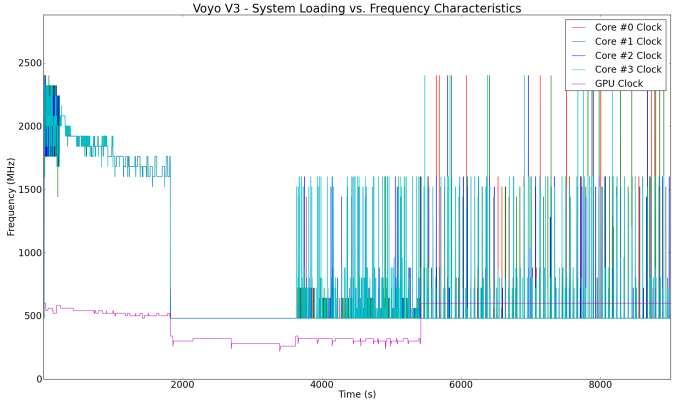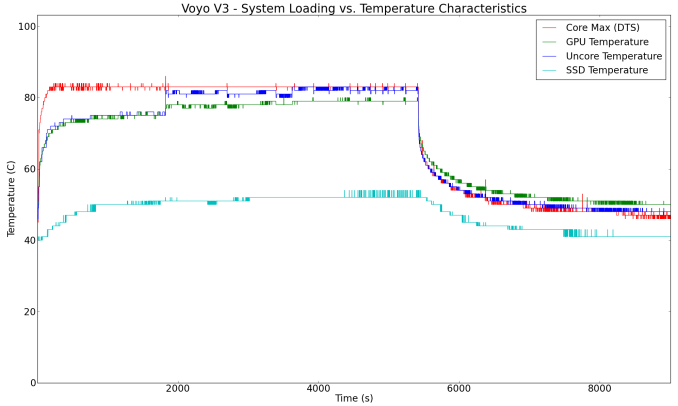Voyo V3 Review - A Fanless Intel Atom x7-Z8700 (Cherry Trail) mini-PC
by Ganesh T S on March 1, 2016 8:00 AM EST- Posted in
- Systems
- Intel
- Atom
- Passive Cooling
- Mini-PC
- Cherry Trail
Power Consumption and Thermal Performance
The power consumption at the wall was measured with a 1080p display being driven through the HDMI port. In the graphs below, we compare the idle and load power of the Voyo V3 with other low power PCs evaluated before. For load power consumption, we ran Furmark 1.12.0 and Prime95 v27.9 together. Given that the BIOS of the machine is not really optimized, the idle power being more than most comparable PCs is not surprising.


The load power consumption numbers can also be easily explained. The Atom x7-Z8700 has a SDP of only 2W, and it is definitely less power hungry compared to the Intel Celeron N3000 in the ASRock Beebox. However, it does lose out to the Bay Trail Compute Stick - this could be due to the power consumption of the extra components on the board such as the PCIe - SATA bridge and the faster clocks in the Cherry Trail SoC.
Our thermal stress routine starts with the system at idle, followed by 30 minutes of pure CPU loading. This is followed by another 30 minutes of both CPU and GPU being loaded simultaneously. After this, the CPU load gets removed, allowing the GPU to be loaded alone for another 30 minutes. The various clocks in the system as well as the temperatures within the unit are presented below.
The core clocks briefly operate at the maximum turbo frequency (2.4 GHz), but gradually scale down to the base clock (1.6 GHz) as the load is sustained. Thankfully, the thermal solution is decent enough to prevent the SoC from throttling. The GPU clock measurement has the usual Intel 'bug' where the measured clock is the maximum clock rate even when the GPU is not loaded. As soon as the GPU starts getting loaded, it moves between 200 - 300 MHz while keeping the power consumption of the whole system around 10 W.
According to the official specifications, the junction temperature of the Atom x7-Z8700 is 90C. Fortunately, after enabling DTS in the BIOS, we find that the maximum temperature of any of the board components is kept below 85C even under extreme stress.
Another important aspect to keep note of while evaluating fanless PCs is the chassis temperature. Using the Android version of the FLIR One thermal imager, we observed the chassis temperature after the CPU package temperature reached the steady state value in the above graph. Note that the picture below was taken after manually turning up the operating unit to expose the underside (metallic part abutting the black thermal film which covers the main board components).
We have additional thermal images in the gallery below.
The good part here is that even under extreme stress, the chassis doesn't heat up beyond 50 C. The bad part is that a lot of performance is left on the table (in terms of allowing the SoC to sustain turbo clocks for a longer duration) due to inefficient thermal design. Allowing for the metallic segment to be on top to aid convective cooling would have definitely helped in making the thermal performance better.



















69 Comments
View All Comments
ganeshts - Tuesday, March 1, 2016 - link
As you can see from the thermal stress graphs, the GPU clocks in around 280 MHz for the Furmark stress test. It is always above the base clock claimed by Intel (200 MHz). In any case, the configuration is such that the total power draw by the system at the wall doesn't exceed 10W under any circumstance (obviously, power draw by any connected USB peripherals is excluded).woggs - Tuesday, March 1, 2016 - link
How do you know you didn't get viruses or other spy-ware for a Chinese file sharing site? I've seen this happen on low-end and high-end systems going direct to vendor sites for drivers in some cases, which resulted in attempts to create an encrypted link back to Chinese IP addresses. The description of issues raise lots of red flags.ganeshts - Tuesday, March 1, 2016 - link
I downloaded on to a VM first. Mounted with 'Dism' on the VM and scanned with Windows Defender before moving it to the Voyo V3 / main network.But, yes, Voyo needs to make the drivers available separately.
user_5447 - Tuesday, March 1, 2016 - link
Why iperf (ip perf) is confusingly written as iPerf in Wi-Fi graphs?Shadowmaster625 - Tuesday, March 1, 2016 - link
This bifurcated market remains an insulting joke. You can buy these types of systems for $150 all day long. But simply upgrade the atom into a Core m and all the sudden the price is jacked up by $300? That is so insulting that I wouldnt even contemplate buying either.DanNeely - Tuesday, March 1, 2016 - link
Most of that's down to Intel's pricing. $40 for atom, vs $280 for core M. Implementing a Core M system is more expensive as well, the SoC has 30% more contacts (FCBGA 1515 vs 1170), some of which correspond to extra mobo traces (more expensive PCB). Component wise, you're also looking at 2 channels of ram not 1 for at few more dollars of parts.The OEMs are probably charging slightly higher margins since Core M is branded as a premium product not race to the bottom, and retail margins are generally a percentage of the price not a flat dollar amount; but most of the price difference is down to Intel's pricing. Their holding good mobile CPU prices (ie not their cheap lines: Atom, Pentium, Celeron) at floor of nearly $200 is all about maximizing returns in a portion of the market that they have nearly no effective competition at present. (Hopefully Zen will let AMD compete in CPU performance/watt in the ultrabook processor category soon.)
DanNeely - Tuesday, March 1, 2016 - link
Lastly, Core M is priced at a premium to core i3/5/7 because they're dies that're binned for working decently at extra low power levels, the intermediate level Celeron/Pentium lines are much cheaper because they're a dumping ground for duds.dsraa - Tuesday, March 1, 2016 - link
$359 on the 'advertised' amazon link.....pffft. Ain't buying it from there almost 2x as much.....yuck.ganeshts - Tuesday, March 1, 2016 - link
You can always use the Gearbest link that is in the final page (just prior to the Amazon link) which reflects the true value / non-inflated cost of the system - around $200.jimbo2779 - Thursday, March 3, 2016 - link
I would never deal with gearbest. Do your research on them, they are terrible, absolutely awful.Their trustpilot reviews are faked so look elsewhere and you get an idea of the type of company they are.